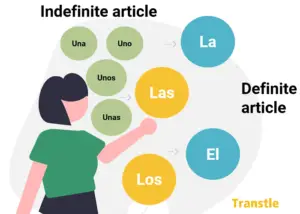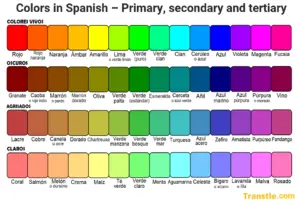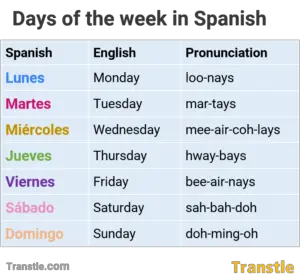Spanish Greetings, Farewells, More: Full List, Examples, Exercises
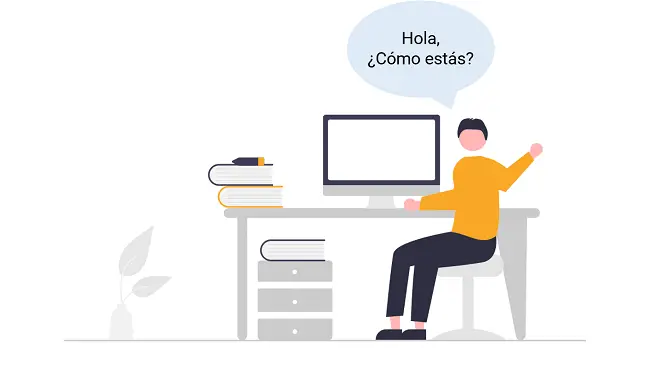
Greetings, farewells, and introductions in Spanish are words that are used to greet, say goodbye, introduce oneself or thers, to know how someone is doing, etc. They are used to to acknowledge someone’s presence, arrival, or departure and convey politeness, respect, courtesy, and etiquette.
Some of these Spanish expressions are more common than others, and the level of formality also varies.
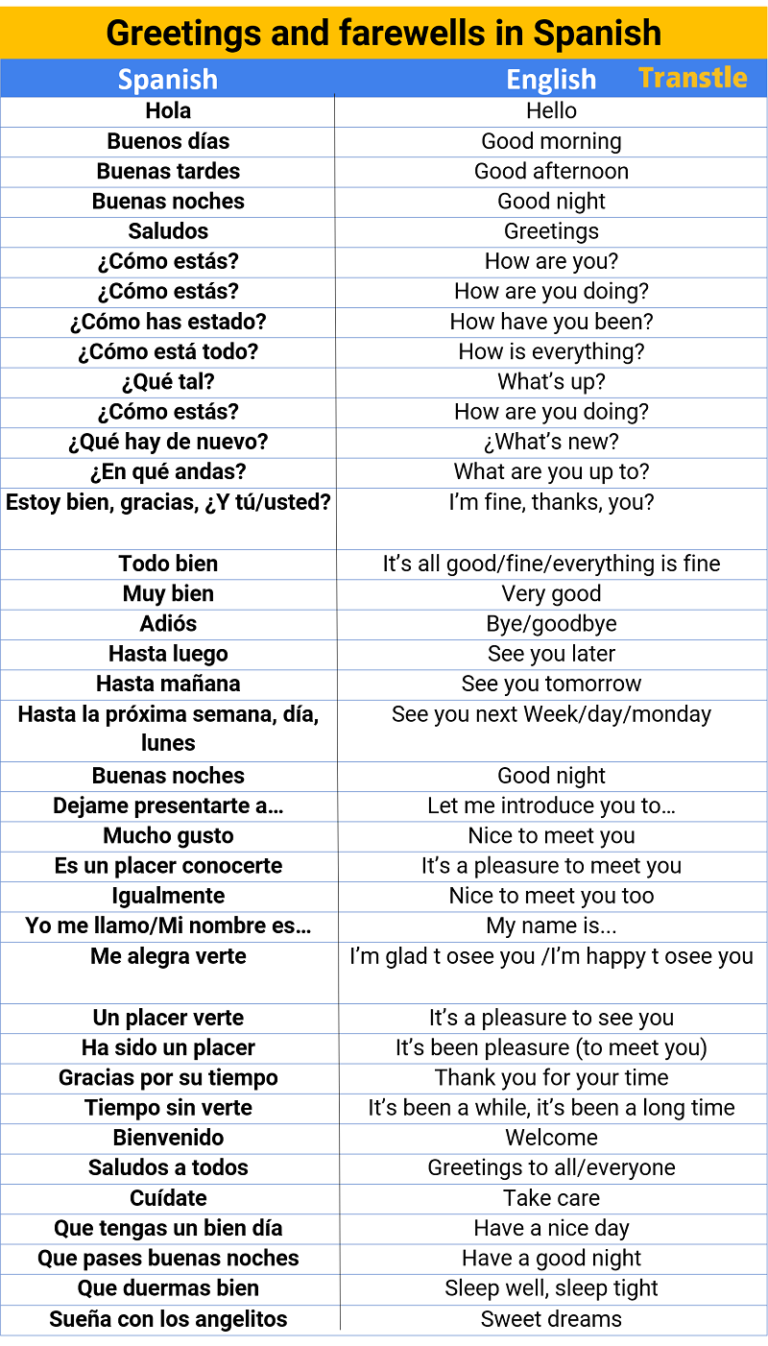
How say hello in Spanish
| Spanish | English |
| Hola | Hello |
| Buenos días | Good morning |
| Buenas tardes | Good afternoon |
| Buenas noches | Good evening/night |
| Saludos | Greetings |
Spanish greetings adopt a plural form, which is a literal translation of “Good days”, “Good nights”, “Good evenings”, etc. Although it is possible to hear someone using the singular form “buen día” instead of “buenos días”, it is not very common.
How are you
Formal
In Spanish, when you address someone, the choice of pronoun to use depends on the level of formality in the relationship.
Formal greetings are typically used in professional or formal settings, when addressing someone who is older, in a position of authority, or someone you don’t know very well. In these situations, it is important to use the appropriate title and show respect.
| Subject pronoun | Spanish | English |
| Tú | ¿Como estás? | How are you? |
| ¿Cómo estás tú? | ||
| Usted | ¿Cómo está? | |
| ¿Cómo está usted? |
Use “Tú when speaking to someone with whom you have a casual relationship, such as a friend, relative, or someone younger than you.
On the other hand, use “Usted” when speaking to someone with whom you have a formal relationship, such as a boss, someone you don’t know well, or someone significantly older than you.
Learn more about Tú and Usted.
Casual
| Spanish | English |
| ¿Qué tal? | What’s up? |
| ¿Cómo haz estado? | How have you been? |
| ¿Qué tal todo? | How is everything? |
| ¿Cómo andas? | How are you doing? |
| ¿Qué cuentas? | What’s up? |
| ¿Qué hay de nuevo? | What’s new? Or What’s up? |
| ¿Como va todo? | How is everything going? |
| ¿Cómo va? | How is it? ¿What’s up? |
| ¿En que andas? | What are you up to? |
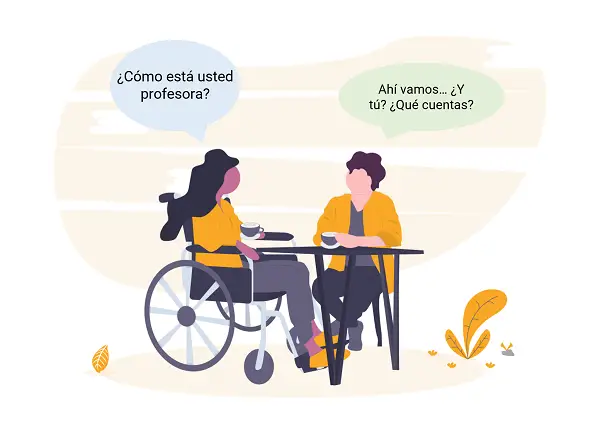
Fine, thanks
| Spanish | English |
| Estoy bien, gracias, ¿Y tú/usted? | I’m fine, thanks, you? |
| Muy bien, gracias, ¿Y tú/usted? | |
| Todo bien | It’s all good/fine/everything is fine |
| Muy bien | Very good |
“Em kind of fine”
Ahí vamos | Literal: “Here, there we are/go…” it means, surviving, hanging in there, kind of fine. |
Aquí estamos |
These last two examples mentioned, “Ahí vamos” , “más o menos”, are often used when someone is asked how they are feeling and they don’t want to give a definitive answer. These expressions convey the idea that the person is not feeling great, but they are not feeling terrible either.
Farewells: Saying goodbye
| Spanish | English |
| Adiós | Bye/goodbye |
| Chao | Bye/goodbye |
| Hasta luego | See you later |
| Hasta mañana | See you tomorrow |
| Hasta la próxima semana, día, lunes | See you next Week/day/monday |
| Buenas noches | Good night |
Greetings include the days of the week, it is recommended that you learn them too.
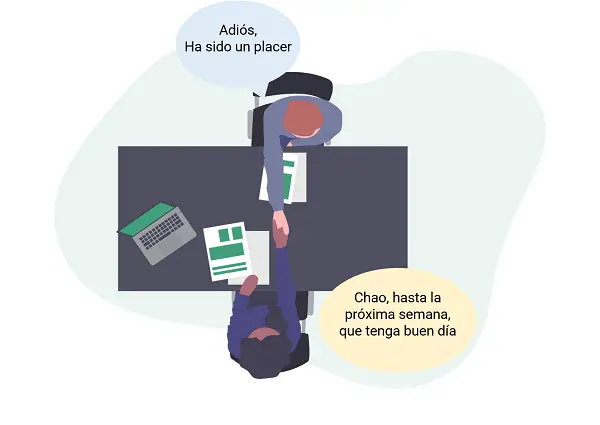
Other common expressions
| Spanish | English |
| Me alegra verte | I’m glad t osee you /I’m happy t osee you |
| Un placer verte | It’s a pleasure to see you |
| Un placer conocerte | Nice to meet you, it’s a pleasure to meet you |
| Ha sido un placer | It’s been pleasure (to meet you) |
| Igualmente | Likewise |
| Gracias por su tiempo | Thank you for your time |
| Tiempo sin verte | It’s been a while, it’s been a long time |
| Bienvenido | Welcome |
| Saludos a todos | Greetings to all/everyone |
| Cuidate | Take care |
| Que tengas un bien día | Have a nice day |
| Que pases buenas noches | Have a good night |
| Que duermas bien | Sleep well, sleep tight |
| Sueña con los angelitos | Literally “dream with little angels” it means “sweet dreams” |
Spanish greetings dialogue
Now you will read an example of a conversation of three persons greeting each other, introducing and saying goodbye, they are using the pronoun Tu because they are friends.
Conversation
- Marcos: ¡Hola Maria!
- Maria: ¡Hola Marcos!
- Marcos: ¿Cómo estás?
- Maria: Estoy bien, ¿y tú?
- Marcos: Estoy bien, gracias, ¡tiempo sin verte!
- Maria: Sí, es cierto, ¿qué cuentas?
- Marcos: Ahora vivo aquí en Mexico.
- Maria: ¡Que buenas noticias! Oh, Marcos, este es mi prometido.Marcos: Hola, ¡mucho gusto!
- Nicolas: Hola Marcos, mi nombre es Nicolas.
- Marcos: ¿Eres español?
- Nicolas: Sí, soy de España, es mi primera vez en Mexico.
- Marcos: ¡Bienvenidos entonces!
- Maria: Le encanta Mexico.
- Marcos: Sí, es un país hermoso.
- Maria: ¿Qué hora es? Creo que tenemos que irnos.
- Marcos: Está bien, que bueno verte Maria, espero verte de nuevo.
- Maria: Sí, yo también.
- Nicolas: Podemos ir a cenar todos este sábado.
- Marcos: Sí, ¡sería fantástico!
- Maria: ¡Perfecto! Entonces te llamaré mañana, hasta el sábado.
- Marcos: Nos vemos, buenas noches.
- Nicolás: Que pasen buenas noches, cuídense.
Exercise
1. Translate the following sentences into Spanish:
- Hello how are you?
- Good morning, my name is Juan.
- Hello! How is everything? Glad to see you again.
- Goodbye, it was nice meeting you. See you tomorrow.
2. Imagine a conversation with someone using some of the words you learned today, then translate it into Spanish and write it.
Answers
- ¿Hola, cómo estás?
- Buenos días, mi nombre es Juan.
- ¡Hola! ¿Cómo va todo? Me alegra verte de nuevo.
- Adiós, fue un placer conocerte. Nos vemos mañana. (or hasta mañana)
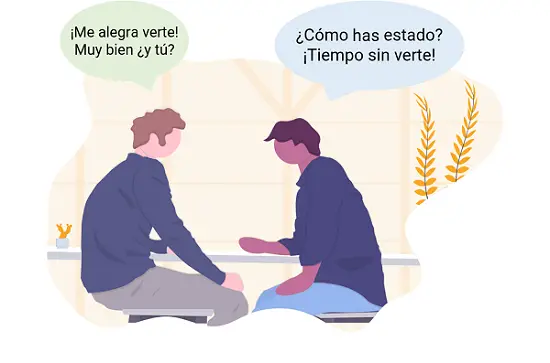
Read next

